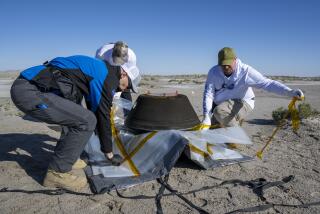Space ‘Construction Firm’ Comes Home as Shuttle Atlantis Lands at Edwards AFB
- Share via
EDWARDS AIR FORCE BASE — The space shuttle Atlantis made a perfect--but extra long--landing on a concrete runway here Tuesday, bringing back on-the-job outer space construction data and samples of a hormone purified in the zero gravity of outer space that could benefit millions of blood disease sufferers.
Commander Brewster Shaw and co-pilot Bryan O’Connor brought the shuttle to a gentle touchdown one minute ahead of schedule at 1:33 p.m.
The Atlantis used up 10,800 feet of the 15,000-foot concrete strip--about 3,000 feet more than previous landings. There was no explanation of why the extra distance was needed.
Twin Sonic Booms
Its path over Malibu and the San Fernando Valley set off characteristic twin sonic booms that could be heard over a large part of the Los Angeles basin. Use of the concrete strip was necessary because rain at this sprawling desert base had turned normally dry Edwards Dry Lake into a field of mud.
The landing of the Atlantis and its seven-member crew ended a flight that had begun seven days before with a night takeoff from Florida that set off a spectacular light show, seen as far away as South Carolina.
Jesse Moore, NASA space flight director, said after the landing that “Atlantis looks just beautiful, there are just a few dings up front and around the landing gear.” He said he had not seen any loose tiles or breaks in the thermal system that protects the shuttle from heat during reentry into the atmosphere.
As the Atlantis landed, technicians at Kennedy Space Center at Cape Canaveral, Fla., were preparing another shuttle, Columbia, for a scheduled Dec. 18 launching. Columbia is to land two days before Christmas at the Kennedy Space Center in Florida. The next shuttle to land at Edwards will be Discovery, after it lifts off from the new West Coast launching site at Vandenberg Air Force Base on a mission now scheduled for mid-July.
Erected Tower in Space
The landing ended the short but productive life of the Ace Construction Co. in the persons of astronauts Sherwood Spring and Jerry Ross, who repeatedly erected a 75-foot tower and 45-foot pyramid while in orbit and brought back videotapes and other monitoring data of their accomplishment.
Space flight director Moore said the work was so successful that it sets the National Aeronautics and Space Administration on its course of building a huge space station as early as 1992.
James Rose, project manager for McDonnell Douglas’ zero gravity electrophoresis manufacturing system for pharmaceuticals, said that results from this experiment--administered by the firm’s on-board mission specialist, Charles Walker--could produce a liter of the substance that could be ready for human testing. Other sources have said the drug could be available as early as 1988. The experiment purified a blood hormone called erythropoietin, which could be used in the treatment of red cell deficiency.
Photos of Comet
The crew brought back pictures taken by astronaut Mary Cleave and others of the drought-stricken areas of Somalia and Ethiopia and photos of earthquake damage in Mexico taken by the first Mexican astronaut, Rodolfo Neri. Cleave took photographs of Halley’s comet also, but results of all the photography will not be known for about two weeks, Moore said.
Early in the flight, the astronauts launched Australian, Mexican and U.S. RCA communication satellites.
More to Read
Sign up for Essential California
The most important California stories and recommendations in your inbox every morning.
You may occasionally receive promotional content from the Los Angeles Times.












